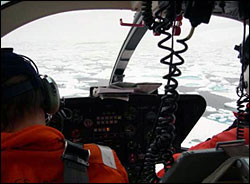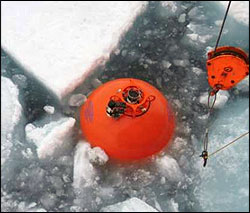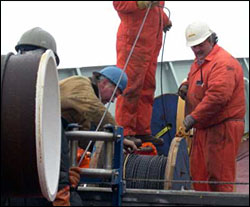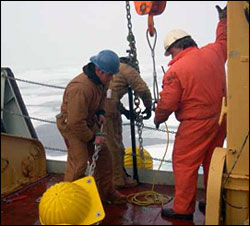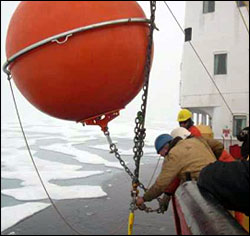Please note: You are viewing
the unstyled version of this website. Either your browser does not support CSS
(cascading style sheets) or it has been disabled. Skip
navigation.
Rick KrishfieldAugust 15-17, 2004
In order to see if the conditions might improve the next day, Joe Fraser flies the ice observer Dan Crosbie, Sarah Zimmermann and myself on a reconnaissance flight using the helicopter to check out the ice conditions upstream. Since the drift has been to the SE, we head NW and spot some open patches beginning around 4 miles away. Near 10 miles away, there are some large patches of open water. At half a knot drift, the open patches should arrive on site the next morning; perfectly timed for our deck work. So the decision is made to wait on the mooring recovery and do several CTD/Rosette casts. The weather is better the next morning - not so much wind. The spaces of open water did arrive, and we recover mooring B. First the ice is broken up between two large leads, then the ship positions itself over the mooring site, and creates a pond to the starboard side (where the A-frame is). The surface package pops right up in the pond. The recovery goes smoother than the first one, and the MMP is retrieved sitting on the bottom bumper while trying to crawl up the wire. This is a good sign that the system worked the whole time. The lower shots of wire are tangled, but not as bad as the first. This time, instead of dragging the end of the mooring through the ice, the Captain steams slowly toward the floats at the end, while the winch takes in the wire. Everything is successfully retrieved by noon, and we even make it to lunch on time. Monday is a beautiful morning, while we steam to our northernmost point of the cruise (79 deg 20 minute N) for CTDs. We have had a lot of overcast days, but today is sunny and bright. I can't understand why we can't have a day like today when we're on deck doing mooring work! The WHOI group spend most of the day dumping ice thickness, bottom pressure measurements, and seawater temperature, salinity, and velocity data from the instruments and refitting the mooring equipment for redeployment. Of course, the next day is yet another dreary cold day for mooring operations. But the mooring deployment is a success. After positioning the ship for about an hour and a half, the deployment takes only about 3.5 hours. When the deck work is done well, as it is under the guidance of John Kemp and the ship's Bosun, Blaine Blinkhorn, then it almost becomes easy. Credit also the conscience support of the Deck Crew, and the expertise on the Bridge to maneuver the ship around the ice during the deployment.
Last updated: October 7, 2019 | ||||||||||||||||||||||
Copyright ©2007 Woods Hole Oceanographic Institution, All Rights Reserved, Privacy Policy. | ||||||||||||||||||||||


